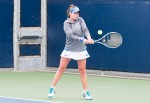There may be something to be said for strength in numbers.
The No. 13 UCLA women’s tennis team (3-0) finds itself entering the season with a 10-player roster – one player larger than last year’s, but the second smallest in the previous nine.
Prior to the last two seasons, the Bruins averaged a 13-player roster.
Despite the comparatively low number of rostered players this year, No. 16 sophomore Ena Shibahara believes her team is deeper than most.
“I think since we have a lot more depth this year, it’s going to come down to trusting each other,” Shibahara said. “Believing in everyone is going to help us get those wins.”
However, there is a correlation between the size of the team’s roster and its winning percentage. With a 14-player roster, the team averages a .835 winning percentage, and with a 12-player roster, the average winning percentage is .818.
With last year’s nine-player roster, the Bruins’ winning percentage was .609.
This correlation makes sense. With a smaller roster, there is less room for rotation, fewer opportunities to try new pairings and higher risk of injury due to overworked muscles.
In fact, the smaller roster may lead to increased fatigue toward the end of each match. Since the doubles round is played first, players may be tired by the time they play singles.
In 2016, the Bruins boasted a 12-player roster, while in 2017 the team had only nine players. The smaller roster won 82.6 percent of its doubles points, while the larger roster won only 57.1 percent, the latter finishing with a higher winning percentage.
When the Bruins’ 12-player roster won the doubles point, they won the match 83.3 percent of the time.
When the nine-player roster won the doubles point, UCLA won the match 73.7 percent of the time, about 10 percent less.
However, this year’s team has accumulated a 3-0 record thus far, and has only won the doubles point once. Coach Stella Sampras Webster attributes this to the depth of talent, rather than numbers, on her roster.
“It was a good lesson for the team, (Shibahara and Jada Hart) losing, and seeing that we were still able to win that match,” Sampras Webster said. “It’s nice to have such depth on our team.”
No. 119 redshirt sophomore Hart echoed the sentiment, mentioning that while the Bruins’ roster last year had nine players, there were only six playing in matches.
“Even though (this year) we have fewer players, we have more quality players,” Hart said. “So if a couple people need to sit out of some matches, we have some great players that are able to come in. Last year we didn’t have that capability. … We had six people playing every single match.”
Maybe this year’s roster has enough talent to make up for its size, but UCLA seems to succeed with rosters of 12 or more. The average winning percentage of Bruin teams of this size is .818 over the past nine years.
If this year follows the pattern between roster size and winning percentage of UCLA’s last nine seasons, the 10-player roster will finish with a .674 winning percentage. In comparison, the Pac-12 champions over the past five years have averaged a winning percentage of .855.
If the women’s tennis team wants a shot at this year’s title, the Bruins will need to stay healthy.

Obviously losing top recruit Caroline Dolehide who turned pro early has hurt the Bruins chances of being a top 5 team. The Bruins will need some luck like staying free from injury to have a big year.